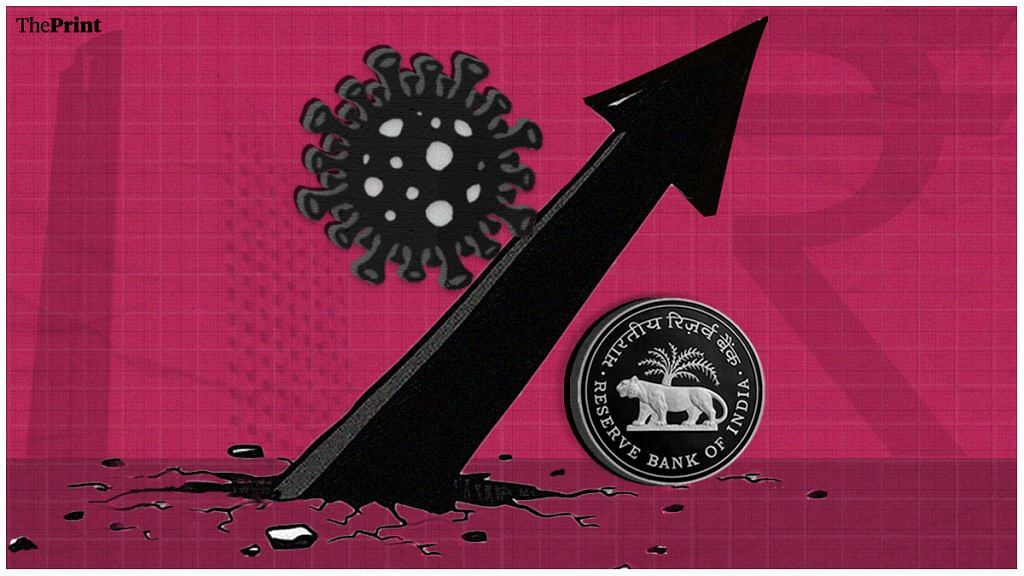In its April monetary policy review, the Reserve Bank of India announced a new policy tool to calm the bond markets. The RBI committed to buying Rs 1 trillion (one lakh crore) worth of government securities in the secondary market in the first quarter of the current financial year 2021-22.
The new tool, called the G-Sec Acquisition Programme (G-SAP) 1.0, was announced to bring down the cost of borrowings for the government and counter the upward pressure on yields due to a higher government borrowing programme.
The RBI’s Monetary Policy Committee (MPC) maintained the status quo on policy rate for the fifth time in a row. The reverse repo rate was left unchanged at 3.35 per cent. The RBI has also decided to maintain an accommodative stance as long as necessary to support growth.
Also read: Why RBI needs to be relieved from debt management duties to handle bond market issues
Quantitative Easing
The central bank has so far been trying to bring down the interest rate on government bonds through open market purchases. The G-SAP is similar to announcing a definite calendar for open market purchases of government bonds. It is a variant of the Quantitative Easing (QE) policy followed by central banks in advanced economies in the aftermath of the global financial crisis.
Under QE, central banks conduct large-scale purchases of assets, including treasury bills and private sector bonds, to directly influence interest rates and risk premiums on private debt.
The RBI is committing to buy only government securities. In the recent period, central banks of emerging economies have resorted to QE to prevent surges in local bond yields and to communicate that central banks are ready to purchase government bonds amid large fiscal expansion to respond to the pandemic shock.
This announcement provides certainty to bond investors that the RBI will step in to buy bonds, infuse liquidity and bring down yields. The yield on government bonds have been inching up amid an elevated market borrowing plan, and also due to spill-overs from a spike in US bond yields.
Contrasting reactions
The decision to announce G-SAP led to contrasting reactions. While the bond market cheered the decision with the 10-year bond yield dropping as much as 7 basis points, the rupee slid 1.52 per cent and closed at 74.56 — the lowest since November 2020.
Foreign capital flows in from, say, the US when the interest rate differential between US and India is high. An investor might borrow from a country where rates are low and invest in a country where yields are higher. Up until recently, this differential between the rates was driving the flow of capital to India and causing the rupee to appreciate. However, in the past few months, due to aggressive bond purchases by the RBI, yields have risen at a much slower pace.
On the contrary, in the US, bond yields have been inching up at a much faster pace from their record lows. As a result, the spread between India’s 10-year bond and the US’ 10-year bond has narrowed. The 10-year bond yields fell to 6.06 per cent after the monetary policy announcement, and triggered the aforementioned sharp depreciation of the rupee.
Also read: Why Modi govt has done well to maintain continuity in inflation targeting framework
Tough balancing act
As a debt manager to the government, the RBI is announcing measures to bring down the interest on government bonds, but as inflation concerns have emerged, the RBI has to raise interest rates to prevent price rise.
The conflict between the RBI’s role as a debt manager and as an inflation targeting central bank could sharpen over the coming months, thus complicating policy adjustments. The RBI Governor too has acknowledged that it has to strike the right balance as it is managing a number of conflicting objectives.
While the decision to leave the policy rate and the stance unchanged was expected and desirable, the RBI has to do a tough balancing act of sustaining the recovery and managing inflation expectations amid a surge in inflation. The recent resurgence in Covid-19 cases has created uncertainty over economic growth revival. While there is a downside risk to near-term growth outlook due to re-imposition of localised lockdowns, a pick-up in vaccination drive and improvement in global growth could limit the downside risks to growth. Perhaps, that is the reason the RBI retained its growth forecast at 10.5 per cent for the current year.
Unlike in advanced economies, where inflation is well below the target, inflation in India has remained elevated for most part of the last year. Elevated commodity prices and logistics costs are posing an upside risk to inflation. While edible oils and pulses inflation has remained firm, core inflation has picked up in recent months, resulting in a broad-based rise in inflation.
While growth continues to remain the priority for the RBI, the trade-off between supporting growth recovery and managing inflation expectations could turn challenging in the coming months.
Ila Patnaik is an economist and a professor at National Institute of Public Finance and Policy.
Radhika Pandey is a consultant at NIPFP.
Views are personal.
Also read: Why Modi govt must stop depending on petrol, diesel taxes to bridge its fiscal deficit
